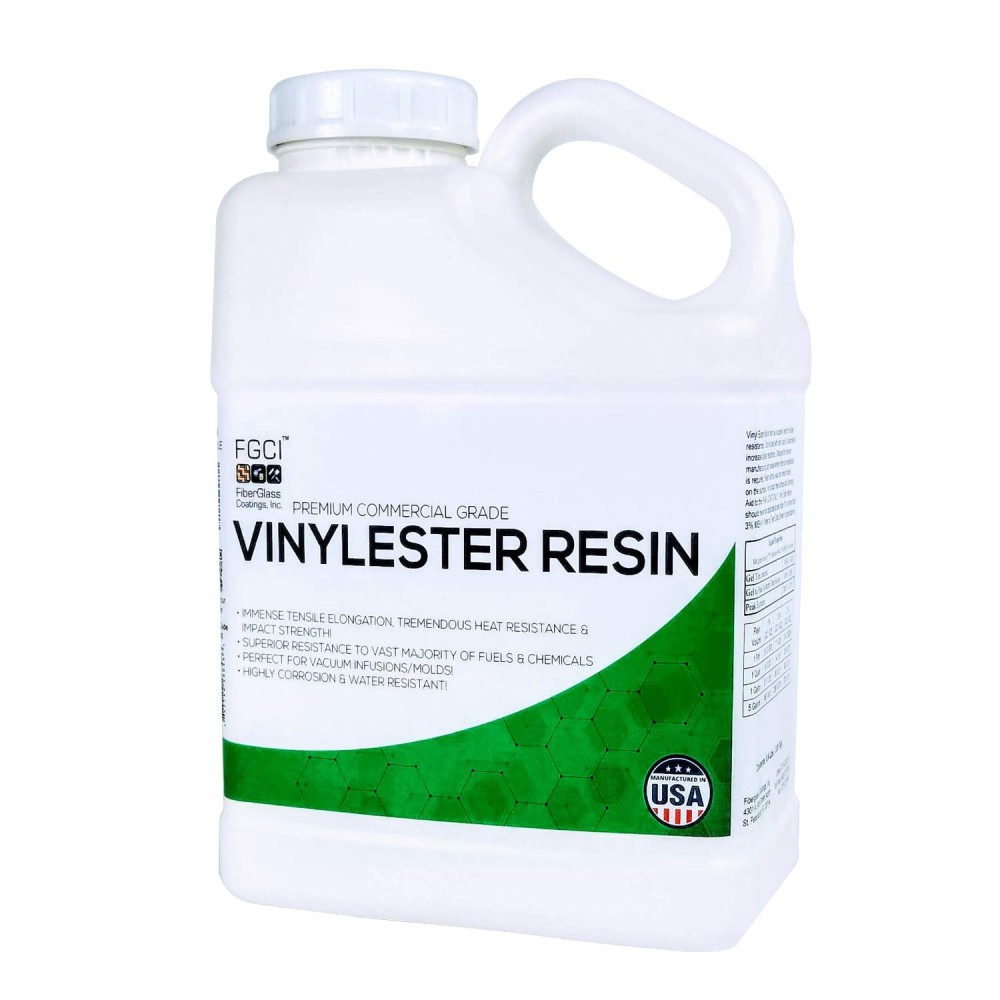Product Description
Vinylester Resin Kit Quart w/2 oz. MEKP. Reichhold Hydrex 33350-99 Vinylester Resin. Highest quality complete laminating resin. Superior resistance to blistering, impact cracks & reinforcement print through. Wets out fiberglass easier than most resins.
- IMMENSE TENSILE ELONGATION, TREMENDOUS HEAT RESISTANCE & IMPACT STRENGTH!
- SUPERIOR RESISTANCE To Vast Majority Of Fuels and Chemicals!
- PERFECT FOR Vacuum Infusion/Molds! Low Viscosity, Effortless To Pour!
- HIGHLY CORROSION / WATER RESISTANT & CREATES A Highly Durable Finished Product!
- 100% MADE IN THE U.S.!
SUPERIOR RESISTANCE to blistering, impact cracks and reinforcement print through! Our Vinyl Ester Resin is a HIGH QUALITY PERFORMANCE laminating resin. It is perfectly suited for:
✔ Marine Applications Such As FRP Gas Tanks
✔ Skin Coat Application To Inhibit Blisters In New Products!
✔ Excellent For Blister Repairs!
✔ DIY Electric Airplane Models, Large Hanging Models, Propellers & Anything To Do w/ Flying RC model airplanes
Size: Gallon
Included: 3 Ounces of MEKP
Optional: Sanding aid/ wax additive (Add to the final coat to allow a full cure and a tack-free surface)
*This Item Ships From Florida Click to See Estimated Transit Times

Directions for Use:
Step 1: Choose the appropriate volume for your project. The type of fiberglass used will determine the amount of resin needed.
Step 2: Make sure to agitate or stir the product thoroughly before use.
Step 3: Mix in the MEKP, stirring thoroughly. Please refer to the Catalyst Concentration Chart for quantities.
Step 4: Thinner fiberglass can easily be wet through. To thoroughly wet out heavier materials, apply resin first to one side, then flip the glass over to wet out the other side. Use paint-style rollers to distribute resin quickly.
Step 5: Roll each layer with a glass roller to remove air. The fiberglass will go completely transparent when it is adequately wet.
Step 6: Add wax addtive sanding aid to the final coat to allow a full cure and a tack-free surface.
Additional Information:
- We recommend testing a sample piece before beginning your final project.
- Avoid using this product in direct sunlight.
- The ideal temperature for using this product is 77°F. Best results for this product can be obtained at temperatures between 70°F and 85°F, in a clean, dry, dust-free environment.
- For best results, do not wet out fiberglass to over 1/8” in thickness. Use of more than 1/8” may generate excessive heat. Allow previous layer to tack up, but not fully cure, prior to pouring next layer.
- Vinylester resin has excellent performance properties including increased thermal resistance and the ability to withstand corrosion, water absorption, impact, and de-molding cracking.
- Vinylester resin is used extensively for hull construction and is well-suited as a barrier coat for blister resistance. It is often used in the swimming pool industry, as well as for fabricating small-to-large Fiberglass Reinforced Part (FRP) structures, FRP tanks, and vessels.
- If sanding is required to apply more fiberglass to an existing layer, use 36, 24, or 16 grit. Low grits will provide deeper scratches and allow for a better bond between layers. Be sure to clean the surface before applying the next layer.
- To apply gelcoat over resin, prep the surface with 80 grit sandpaper. To apply primer, prep the surface with 220 grit sandpaper. To apply paint, prep the surface with 320 grit sandpaper.
- Clean Up Procedure: Use acetone or lacquer thinner to clean brushes and rollers. A small bucket of the same solvent can be used for cleaning tools.
Vinylester Resin requires 2% MEK-P every time it is used in order to cure properly. (2.56 oz of MEKP per Gallon, or .64 oz per Quart)
- The maximum heat temperature is 220°F.
- This product can be used to help gelcoat bond with epoxy.
- The ideal temperature is at 77°F. Best results for this product can be obtained at temperatures between 70°F and 85°F, in a clean, dry, dust-free environment.
- Do not go over 1/8” in thickness. More than 1/8” in thickness will generate too much heat.
- Add sanding aid/ wax additive to the final coat to allow a full cure and a tack-free surface.
